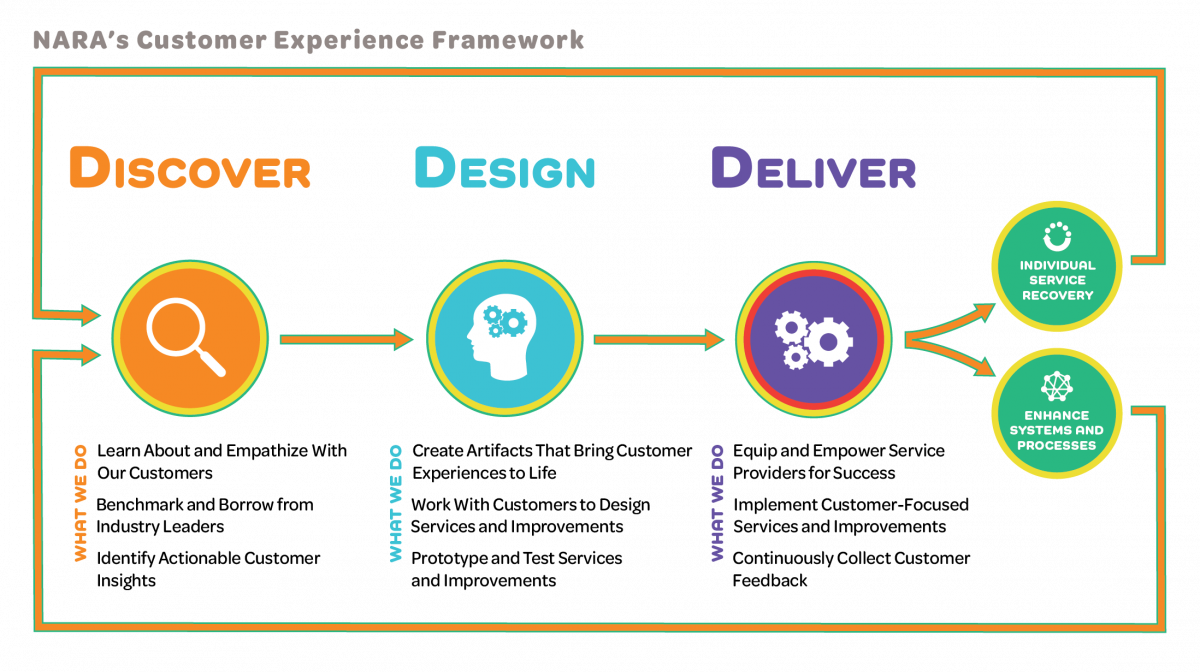
National Archives Expands Human-Centered Approach to Customer Experience
By Editorial Staff | National Archives News

WASHINGTON, March 3, 2022 – The National Archives has a long-standing commitment and record of improving customer experience by listening to its customers and using that information to improve products and services. This year, the agency responsible for safeguarding and providing access to the nation’s most important federal records increased its human-centered design staff and resources to further improve the services it offers through the implementation of an agency-wide customer experience framework.
In a recent talk, Chief Customer Experience Officer Stephanie Bogan said, “Our customers’ experience with the National Archives is one of our highest priorities. Ensuring NARA’s services are as efficient, engaging, and equitable as possible begins by deepening our understanding of the people we serve.”
Human-centered design is a customer-focused and creative approach to strategically improving existing services and designing new services with and for the people that will use them or improve existing services from the customer’s perspective.
“We’re expanding our human-centered approach to improving your Archives experience,” said Nick Bloom, Human-Centered Design Specialist and the newest member of the Customer Experience division in the Office of the Chief of Staff.
Currently, Bloom is working with a group of dedicated staff across the agency to develop an enterprise customer research agenda.
“The agenda is an important tool used to identify agency-level opportunities to deepen understanding of our customers and services, and identify areas where services can be improved. This information will not only facilitate increased engagement with our customers but will also help us better coordinate organizational resources and make data-driven decisions affecting service delivery,” Bloom said.
The National Archives’ customer experience team is collaborating across the agency to identify major lines of business, existing and prospective customer segments, and opportunities to improve the design and delivery of services.
Understanding customers, as represented in orange in the chart at top, fuels the agency’s customer experience framework, and human-centered design is at its core. The framework promotes listening to customers and continuous service delivery improvement.
“We collaborated with the Department of Veterans Affairs Veterans Experience Office to develop NARA’s approach to managing customer experience and improving service delivery,” Bogan said. “As illustrated in the framework, our model aims to bring our customers’ perspectives to life through three phases—discovery, design, and delivery.”
In the discovery phase, the National Archives connects with customers to learn about their perspectives and expectations of the agency through qualitative and quantitative research methodologies like surveys, focus groups, or observational studies. This empowers staff to empathize with customers and keep customer perspectives front and center as they create or improve the ways they serve them. The discovery phase also serves as an opportunity to benchmark with other public and private sector service providers to remain knowledgeable of industry best practices and the latest technology available to enhance service delivery.
In the design phase, the National Archives creates artifacts that bring customer experiences to life through compelling visual aids such as journey maps and service blueprints. These tools educate staff about the customers they serve. The agency also uses these artifacts to support human-centered design initiatives to guide the development or improvement of programs and services. In some cases, customers participate in this process alongside Archives staff.
In the delivery phase, the National Archives implements the improved or new services. Implementation includes equipping and empowering agency staff for customer success, ensuring organizational policies support optimal service delivery, holding the agency accountable by collecting ongoing customer feedback, and using customer feedback to support continuous improvement.
“I’m excited to be championing the team that is developing the agency’s first customer research agenda. It’s an important step in furthering the agency’s application of human-centered approaches to the design and delivery of NARA’s products and services,” said Chief of Staff Maria Carosa Stanwich. The National Archives Customer Experience Agenda is scheduled to be published publicly for review and comment in August 2022.